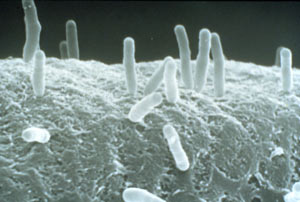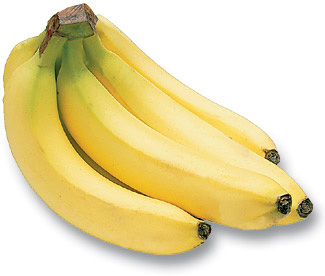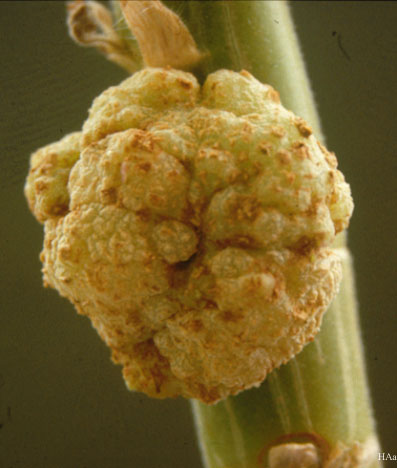Agrobacterium: Difference between revisions
No edit summary |
No edit summary |
||
| Line 36: | Line 36: | ||
<h2>Banana Vaccines </h2> | <h2>Banana Vaccines </h2> | ||
Bananas have potential to become the world's first edible vaccine due to ''Agrobacterium''. An edible vaccine doesn't need sterile syringes, costly refrigeration, or multiple injections. According to the World Health Organization (WHO), more than 2 million children die worldwide each year from diarrhea that can be prevented easily with vaccines. | |||
[[Image:bananas.JPG|frame|left|From [http://www.wegmans.com/kitchen/ingredients/produce/fruit/bananas.asp Wegmans Bananas]]] Thus, researchers lead by Dr. Charles Arntzen are looking into making the food vaccines to prevent diarrhea caused by ''Escherichia coli'' and ''Vibrio cholara'' bacteria. First, the gene for an immune system-stimulating disease protein would have to be spliced into the bacterium. The bacterium is then allowed to contaminate banana cells, inserting the Ti plasmid (containing the spliced gene) into their chromosomes. The next step is to grow the cells until they are mature fruit-bearing plants. The fruits, when eaten, would transfer the immunity to a particular disease into the consumer's body. This would be a relatively inexpensive and feasible method to distribute certain vaccines to people, especially in developing countries. | |||
Bananas have potential to become the world's first edible vaccine due to ''Agrobacterium''. An edible vaccine doesn't need sterile syringes, costly refrigeration, or multiple injections. According to the World Health Organization (WHO), more than 2 million children die worldwide each year from diarrhea that can be prevented easily with vaccines. Thus, researchers lead by Dr. Charles Arntzen are looking into making the food vaccines to prevent diarrhea caused by ''Escherichia coli'' and ''Vibrio cholara'' bacteria. First, the gene for an immune system-stimulating disease protein would have to be spliced into the bacterium. The bacterium is then allowed to contaminate banana cells, inserting the Ti plasmid (containing the spliced gene) into their chromosomes. The next step is to grow the cells until they are mature fruit-bearing plants. The fruits, when eaten, would transfer the immunity to a particular disease into the consumer's body. This would be a relatively inexpensive and feasible method to distribute certain vaccines to people, especially in developing countries. | |||
Revision as of 14:15, 1 June 2006

ClassificationHigher order taxa:Bacteria; Proteobacteria; Alphaproteobacteria; Rhizobiales; Rhizobiaceae; Rhizobium/Agrobacterium groupSpecies:Agrobacterium agile, Agrobacterium albertimagni, Agrobacterium aurantiacum, Agrobacterium larrymoorei, Agrobacterium radiobacter, Agrobacterium rhizogenes, Agrobacterium rubi, Agrobacterium tumefaciens, Agrobacterium vitis, Agrobacterium sp.Description and SignificanceAt the turn of the century Agrobacterium tumefaciens was identified as the causal agent in crown gall disease in dicotyledonous plants. Since then, thorough research has been done on this bacterium's mechanism of tumor induction; in addition, Argorbacterium is used in numerous research projects as a means with which to introduce new genes into the genomes of a number of plants.
Genome StructureAgrobacterium tumefaciens str. C58 has an unusual chromosomal organization - it has a 2 Mb linear and a 2.8 Mb circular chromosome as well as a 206.479 kbp Ti (tumor-inducing) plasmid. The genes that cause gall formation in plants are located for the most part on the the Ti plasmid. Interestingly, if Agrobacterium is grown near its maximum temperature of about 30oC, then the plasmid is lost as well as the pathogenicity of the bacterium. The bacterium itself is still functional and can thrive in culture (Deacon). The genome of Agrobacterium vitis is currnetly being sequenced. It causes gall disease in grapes. Cell Structure and Metabolism
Banana VaccinesBananas have potential to become the world's first edible vaccine due to Agrobacterium. An edible vaccine doesn't need sterile syringes, costly refrigeration, or multiple injections. According to the World Health Organization (WHO), more than 2 million children die worldwide each year from diarrhea that can be prevented easily with vaccines.  From Wegmans Bananas
References Updated July 28, 2005Brown, Kathryn. 1996. "Vaccine Cuisine." Environmental Health Perspectives, vol. 104, no. 3. Abraham Loyter, Joseph Rosenbluh, Nehama Zakai, Jianxiong Li, Stanislav V. Kozlovsky, Tzvi Tzfira and Vitaly Citovsky. The Plant VirE2 Interacting Protein 1. A Molecular Link between the Agrobacterium T-Complex and the Host Cell Chromatin?Plant Physiology, July 2005, Vol. 138, pp. 1318-1321. White, Graham. The Molecular Cell Biology Research Group: Research |

